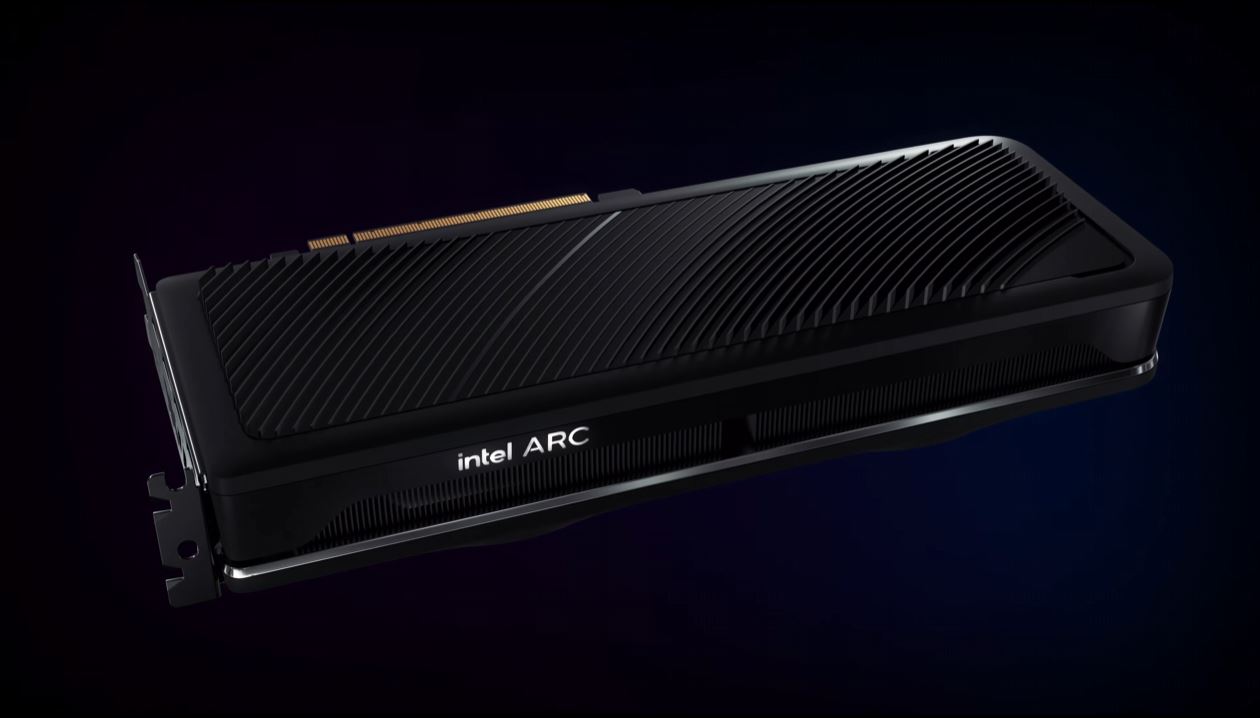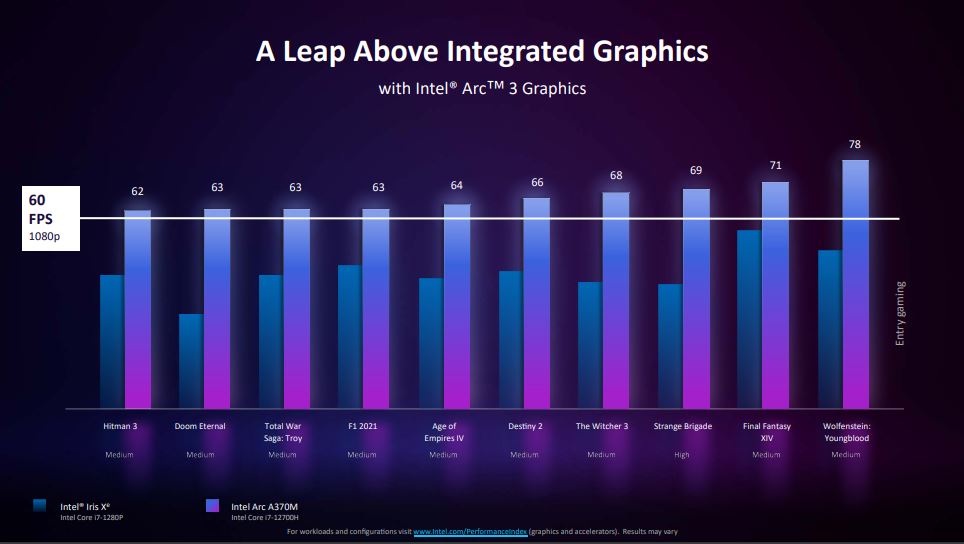Intel Arc GPUs: Specs, price, release date and more
Intel's Arc GPUs have arrived; here's everything we know so far

Intel has finally released its first Arc laptop GPUs and desktop GPUs in the market, bringing some much-needed competition to AMD and Nvidia.
While the desktop cards were initially expected to begin arriving during the summer, though Intel's Arc desktop GPU launch was delayed a bit. However, the Arc 750 and Arc 770 are due to release on October 12, with reviewers already sharing their thoughts online.
Arc graphics cards are discrete GPUs that are more powerful than the Intel Iris Xe GPUs integrated into Intel CPUs. Now that they're here, Intel is in a position to challenge Nvidia and AMD for a significant piece of the graphics card market, which is hotter than it's ever been. It's worth getting excited about.
If these initial Arc graphics cards are the baseline Intel's going to build on in the years ahead, it’s possible we may be in a new GPU arms race.
Here’s everything we know about the Intel Arc GPUs announced so far.
Intel Arc laptop GPUs: Specs
| Row 0 - Cell 0 | Xe cores | Raytracing Units | Memory (GDDR6) |
| A350M | 6 | 6 | 4GB |
| A370M | 8 | 8 | 6GB |
| A550M | 16 | 16 | 8GB |
| A730M | 24 | 24 | 12GB |
| A770M | 32 | 32 | 12GB |
Intel Arc laptop GPUs: Price and availability
Intel launched the A350M and the A370M on March 30, 2022. However, since these are laptop GPUs, there's no way to buy them individually; you'll need to find a laptop that can be configured with them. One of the first laptops to ship with an Arc A-series card is Samsung's Galaxy Book2 Pro, which can be ordered from Samsung's website for a starting price of $1,049.
According to Intel, the A350M is for laptops that prioritize lightness and thinness while the A370M is built for gaming performance. More powerful Arc 5 and Arc 7 GPUs will release later this year in laptops from partners like Acer, Asus, Dell, HP and more, with prices starting at $899.
Get instant access to breaking news, the hottest reviews, great deals and helpful tips.
It's yet unclear if the Arc A-series cards will be the only Arc laptop GPUs for the foreseeable future, or if we should expect other series of Arc mobile GPUs down the line.
Intel Arc laptop GPUs: Performance
The Arc 3 GPUs (aka the A350M and A370M) are the least powerful GPUs in the Intel Arc lineup. Despite that, they're designed to deliver 1080p gaming at 60 to 90 frames per second. Though 1080p can feel pretty pedestrian for many PC game enthusiasts, the promised framerates are potentially impressive for a laptop.
The A350M and A370M both have 4GB of DDR6 RAM, with the former featuring 6 Xe cores and 6 raytracing units and the latter containing 8 of each. These "Xe cores" are, on a very basic level, compute units optimized for gaming and content creation.
Intel says the A350M draws between 25 and 35 watts of power and has a graphics clock of 1,150MHz. The A370M has a 35-50 watt draw due to its 8 XE and 8 RT cores. Like the A350M, this GPU has 1,150MHz graphics clock and 4GB of VRAM.
Intel released a graph showing how various games perform running on Arc GPUs. Titles like Doom Eternal, Destiny 2 and The Witcher 3 ran just shy of 60 frames per second, though it's yet unclear what the specs were of the system used to generate those numbers. If the A350M and A370M are capable of delivering such impressive performance, we can only imagine what the Arc 5 and Arc 7 GPUs will bring to the table — not to mention the inevitable desktop iterations.
Intel Arc laptop GPUs: Features
The Intel Arc laptop GPUs have a competitive feature set, as they ship with support for DirectX 12 Ultimate and hardware-accelerated raytracing.
Thanks to Intel’s new Deep Link technology, Arc GPUs will also have special features that help them work especially well with the company’s 12th Gen Alder Lake CPUs. Because of this, the GPUs should deliver improved performance in compute-intensive applications like Adobe Photoshop, Handbrake and XSplit when used in tandem with a 12th Gen Intel Core processor.
These GPUs also support Intel's XeSS AI-powered supersampling tech, which taps into the power of special Matrix Extensions (XMX) AI engines in the Arc GPUs to algorithmically improve the resolution of games as they're running, without impacting performance. If it works, it should rival similar technologies like Nvidia’s DLSS and AMD’s FidelityFX Super Resolution, with the added bonus that it's not proprietary. That means you could theoretically run XeSS on an Nvidia GPU that's too old to support Nvidia's own DLSS and squeeze better performance out of it using Intel's tech, no Arc GPU required.
However, note that XeSS isn't expected to launch until the summer of 2022, and even then not all games will support it. However, Intel appears to be working with game devs to ensure as many as possible will support XeSS, and there was even an "exclusive integration" in the PC version of Death Stranding Director's Cut that was teased at CES 2022.
Of course, XeSS should work best on an Arc GPU. These GPUs also have an Xe media engine capable of hardware-accelerated AV1 (an open-source media codec) encoding, a feature no other GPU on the market can currently match.
Intel Arc desktop GPUs
The Intel Arc A750 and Arc A770 desktop GPUs release on October 12. The first round of reviews have popped up across the internet. Generally speaking, reviewers seem impressed by the budget-focused GPUs and were surprised by how well they fared against Nvidia’s similarly budget-friendly offerings, such as the Nvidia GeForce RTX 3060 and Nvidia GeForce RTX 3060 Ti. However, some benchmarks revealed less-than-stellar performance for older titles using older drivers.
Back in June 2022, Intel released performance metrics of the Arc A380 in 17 gaming titles and compared said metrics to the GTX 1650 and RX 6400 running on the same PC (via Tom’s Hardware).
On average, Intel’s GPU couldn't match the performance of its rivals, with the GTX 1650 and RX 6400 reportedly outperforming it by 19% and 9%, respectively. Intel's GPU outpaced the RX 6400 in four of the 17 games (including F1 2021 and The Witcher 3: Wild Hunt), and only outdid the GTX 1650 in a single game: Naraka: Bladepoint. Considering that the GTX 1650 and RX 6400 aren’t exactly top-tier GPUs, the Arc A380’s performance in these tests isn’t encouraging.
While the Arc A380 seems less powerful than its direct rivals, its bigger sibling the beefier Intel Arc A750 GPU beat the Nvidia RTX 3060 – at least according to Intel. As far as some of the recent reviews of the Arc 750 and Arc 770 are concerned, it seems Intel's claims weren't far off the mark. The company's cards seem to be comparable to similar offerings from Nvidia.

Intel Arc GPUs: Outlook
With support for hardware-based raytracing, DirectX 12 Ultimate and its new XeSS upscaling tech, Intel's latest graphics cards look set to deliver some much-needed relief to the overheated, undersupplied GPU market.
However, it seems these same features need some time to cook, at least according to reviewers who tested the desktop Arc GPUs. There is potential in Intel's cards, but the company faces an uphill battle with the AMD Ryzen 7000 and RTX 40-series GPUs in the wild. But based on what we know so far, Intel appears to be bringing some serious competition to the GPU market this year.

Tony is a computing writer at Tom’s Guide covering laptops, tablets, Windows, and iOS. During his off-hours, Tony enjoys reading comic books, playing video games, reading speculative fiction novels, and spending too much time on X/Twitter. His non-nerdy pursuits involve attending Hard Rock/Heavy Metal concerts and going to NYC bars with friends and colleagues. His work has appeared in publications such as Laptop Mag, PC Mag, and various independent gaming sites.
- Alex WawroSenior Editor Computing


